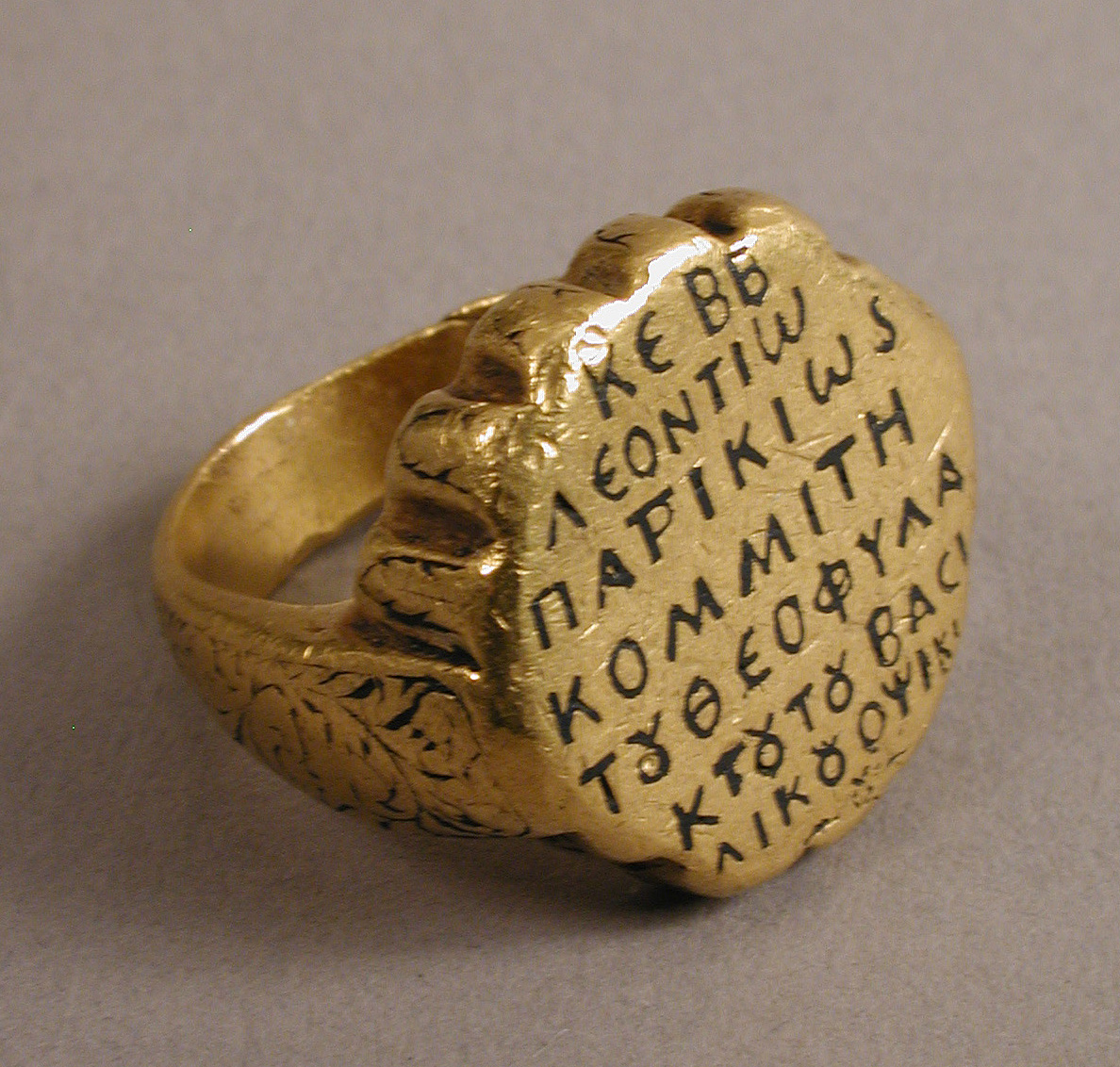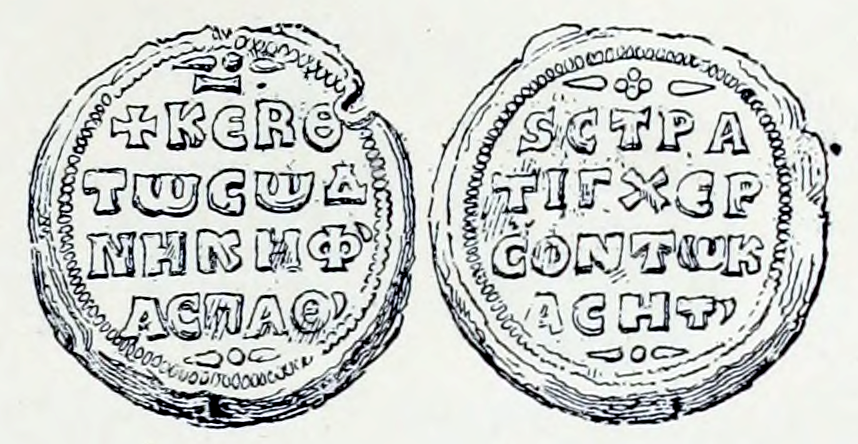|
Emperor Leo IV
Leo IV the Khazar (Greek: Λέων ὁ Χάζαρος, ''Leōn IV ho Khazaros''; 25 January 750 – 8 September 780) was Byzantine emperor from 775 to 780 AD. He was born to Emperor Constantine V and Empress Tzitzak in 750. He was elevated to co-emperor on the next year, in 751, and married to Irene of Athens in 768. When Constantine V died in September 775, while campaigning against the Bulgarians, Leo IV became senior emperor. In 778 Leo raided Abbasid Syria, decisively defeating the Abbasid army outside of Germanicia. Leo died on 8 September 780, of tuberculosis. He was succeeded by his underage son Constantine VI, with Irene serving as regent. History Leo IV was born on 25 January 750AD, to Emperor Constantine V and his first wife, Empress Tzitzak. Because his mother was a Khazar, Leo was given the epithet 'the Khazar'. Leo was elevated to co-emperor in 751, while still an infant. He became emperor on 14 September 775, after Constantine V died while campaigning against the ... [...More Info...] [...Related Items...] OR: [Wikipedia] [Google] [Baidu] |
Solidus (coin)
The ''solidus'' (Latin 'solid'; ''solidi'') or nomisma ( grc-gre, νόμισμα, ''nómisma'', 'coin') was a highly pure gold coin issued in the Late Roman Empire and Byzantine Empire. Constantine introduced the coin, and its weight of about 4.5 grams remained relatively constant for seven centuries. In the Byzantine Empire, the solidus or nomisma remained a highly pure gold coin until the 11th century, when several Byzantine emperors began to strike the coin with less and less gold. The nomisma was finally abolished by Alexius I in 1092, who replaced it with the hyperpyron, which also came to be known as a "bezant". The Byzantine solidus also inspired the originally slightly less pure dinar issued by the Muslim Caliphate. In Western Europe, the solidus was the main gold coin of commerce from late Roman times to Pepin the Short's currency reform, which introduced the silver-based pound/ shilling/ penny system. In Late Antiquity and the Middle Ages, the sol ... [...More Info...] [...Related Items...] OR: [Wikipedia] [Google] [Baidu] |
Epithet
An epithet (, ), also byname, is a descriptive term (word or phrase) known for accompanying or occurring in place of a name and having entered common usage. It has various shades of meaning when applied to seemingly real or fictitious people, divinities, objects, and binomial nomenclature. It can also be a descriptive title: for example, Pallas Athena, Phoebus Apollo, Alfred the Great, Suleiman the Magnificent, and Władysław I the Elbow-high. Many English monarchs have traditional epithets: some of the best known are Edward the Confessor, William the Conqueror, Richard the Lionheart, Æthelred the Unready, John Lackland and Bloody Mary. The word ''epithet'' can also refer to an abusive, defamatory, or derogatory phrase. This use as a euphemism is criticized by Martin Manser and other proponents of linguistic prescription. H. W. Fowler complained that "epithet is suffering a vulgarization that is giving it an abusive imputation." Linguistics Epithets are sometimes ... [...More Info...] [...Related Items...] OR: [Wikipedia] [Google] [Baidu] |
Tatzates
Tatzates or Tatzatios ( el, Τατζάτης or Τατζάτιος, from hy, Տաճատ Tačat) was a prominent Byzantine general of Armenian descent, who in 782 defected to the Abbasids and was appointed governor of ''Arminiya''. Biography Tatzates belonged to the noble Armenian Andzevatsi family. Probably in the 750s, he came to the Byzantine Empire and entered the service of Emperor Constantine V (r. 741–775)... Under Constantine V, he reportedly fought against the Bulgars, and achieved the position of ''strategos'' (general and governor of a theme) by circa 760. It is not known which themes he commanded, but by 776 he led the Bucellarian Theme.. In the same year, he led his army in a successful expedition against the Arabs, reaching Samosata. In 778, he took part in a successful large-scale expedition against Germanikeia under the overall command of Michael Lachanodrakon, and in 781 he fought, again under Lachanodrakon, in the Byzantine victory at Caesarea over an Arab ... [...More Info...] [...Related Items...] OR: [Wikipedia] [Google] [Baidu] |
Bucellarian Theme
The Bucellarian Theme ( el, Βουκελλάριον θέμα, ''Boukellarion thema''), more properly known as the Theme of the Bucellarians ( el, θέμα Βουκελλαρίων, ''thema Boukellariōn'') was a Byzantine theme (a military-civilian province) in northern Asia Minor (modern Turkey). It was created around the middle of the 8th century, comprising most of the ancient region of Paphlagonia and parts of Galatia and Phrygia.. History The theme was established sometime after 743 and before 767 by the Emperor Constantine V (r. 741–775), following the suppression of the revolt of Artabasdos, the Count of the '' Opsikion''. The new theme, along with that of the ''Optimatoi'' was split off from the ''Opsikion'' as formed part of the Emperor's policy to reduce the latter's power... The name of the theme derives from the late Roman '' Bucellarii'', elite cavalry troops of Gothic or Roman origin, often found as privately recruited bodyguard troops. By the early 7th century, t ... [...More Info...] [...Related Items...] OR: [Wikipedia] [Google] [Baidu] |
Armeniac Theme
The Armeniac Theme ( el, , ''Armeniakoi hema'), more properly the Theme of the Armeniacs (Greek: , ''thema Armeniakōi'') was a Byzantine theme (a military-civilian province) located in northeastern Asia Minor (modern Turkey). History The Armeniac Theme was one of the four original themes, established sometime in the mid-7th century out of the territory of Lesser Armenia (also known as "Armenia Minor"). Although the mention of a "George, '' tourmarchēs'' of the Armeniacs" in 629, during the Persian campaigns of Emperor Heraclius (r. 610–641), may suggest the existence of the theme at such an early date, the first unambiguous reference to it in literary sources occurs during the revolt of its general, Saborios, in 667/668.. It is next mentioned on a seal of 717/718. Together with the other themes, it was created from the remnants of one of the field armies of the old East Roman army following the disastrous defeats suffered during the first wave of the Muslim conquests, a proc ... [...More Info...] [...Related Items...] OR: [Wikipedia] [Google] [Baidu] |
Gregory (governor Of Opsikion Theme)
Gregory may refer to: People and fictional characters * Gregory (given name), including a list of people and fictional characters with the given name * Gregory (surname), a surname Places Australia *Gregory, Queensland, a town in the Shire of Burke **Electoral district of Gregory, Queensland, Australia *Gregory, Western Australia. United States *Gregory, South Dakota * Gregory, Tennessee *Gregory, Texas Outer space *Gregory (lunar crater) *Gregory (crater on Venus) Other uses * "Gregory" (''The Americans''), the third episode of the first season of the television series ''The Americans'' See also * Greg (other) * Greggory * Gregoire (other) * Gregor (other) * Gregores (other) * Gregorian (other) * Gregory County (other) * Gregory Highway, Queensland * Gregory National Park, Northern Territory * Gregory River in the Shire of Burke, Queensland * Justice Gregory (other) * Lake Gregory (other) Lake Gre ... [...More Info...] [...Related Items...] OR: [Wikipedia] [Google] [Baidu] |
Opsikion
The Opsician Theme ( gr, θέμα Ὀψικίου, ''thema Opsikiou'') or simply Opsikion (Greek: , from la, Obsequium) was a Byzantine theme (a military-civilian province) located in northwestern Asia Minor (modern Turkey). Created from the imperial retinue army, the ''Opsikion'' was the largest and most prestigious of the early themes, being located closest to Constantinople. Involved in several revolts in the 8th century, it was split in three after ca. 750, and lost its former pre-eminence. It survived as a middle-tier theme until after the Fourth Crusade. History The Opsician theme was one of the first four themes, and has its origin in the praesential armies of the East Roman army. The term ''Opsikion'' derives from the Latin term ''Obsequium'' ("retinue"), which by the early 7th century came to refer to the units escorting the emperor on campaign. It is possible that at an early stage, the ''Opsikion'' was garrisoned inside Constantinople itself. In the 640s, however, fol ... [...More Info...] [...Related Items...] OR: [Wikipedia] [Google] [Baidu] |
Theme (Byzantine District)
The themes or ( el, θέματα, , singular: , ) were the main military/administrative divisions of the middle Byzantine Empire. They were established in the mid-7th century in the aftermath of the Slavic invasion of the Balkans and Muslim conquests of parts of Byzantine territory, and replaced the earlier provincial system established by Diocletian and Constantine the Great. In their origin, the first themes were created from the areas of encampment of the field armies of the East Roman army, and their names corresponded to the military units that had existed in those areas. The theme system reached its apogee in the 9th and 10th centuries, as older themes were split up and the conquest of territory resulted in the creation of new ones. The original theme system underwent significant changes in the 11th and 12th centuries, but the term remained in use as a provincial and financial circumscription until the very end of the Empire. History Background During the late 6th and ... [...More Info...] [...Related Items...] OR: [Wikipedia] [Google] [Baidu] |
Syria (region)
Syria ( Hieroglyphic Luwian: 𔒂𔒠 ''Sura/i''; gr, Συρία) or Sham ( ar, ٱلشَّام, ash-Shām) is the name of a historical region located east of the Mediterranean Sea in Western Asia, broadly synonymous with the Levant. Other synonyms are Greater Syria or Syria-Palestine. The region boundaries have changed throughout history. In modern times, the term "Syria" alone is used to refer to the Arab Republic of Syria. The term is originally derived from Assyria, an ancient civilization centered in northern Mesopotamia, modern-day Iraq. During the Hellenistic period, the term Syria was applied to the entire Levant as Coele-Syria. Under Roman rule, the term was used to refer to the province of Syria, later divided into Syria Phoenicia and Coele Syria, and to the province of Syria Palaestina. Under the Byzantines, the provinces of Syria Prima and Syria Secunda emerged out of Coele Syria. After the Muslim conquest of the Levant, the term was superseded by the A ... [...More Info...] [...Related Items...] OR: [Wikipedia] [Google] [Baidu] |
Cherson (theme)
The Theme of Cherson ( el, , ''thema Chersōnos''), originally and formally called the Klimata (Greek: ) and Korsun', was a Byzantine theme (a military-civilian province) located in the southern Crimea, headquartered at Cherson. The theme was officially established in the early 830s and was an important centre of Black Sea commerce. Despite the destruction of the city of Cherson in the 980s, the theme recovered and prospered, enduring until it became a part of the Empire of Trebizond after the dissolution of the Byzantine Empire in 1204. History The region had been under Roman and later Byzantine imperial control until the early 8th century, but passed under Khazar control thereafter. Byzantine authority was re-established by Emperor Theophilos (r. 829–842), who displayed interest in the northern littoral of the Black Sea and especially his relations with the Khazars. Traditional scholarship dates the establishment of Cherson as the seat of a theme in ca. 833/4,.. but mor ... [...More Info...] [...Related Items...] OR: [Wikipedia] [Google] [Baidu] |




